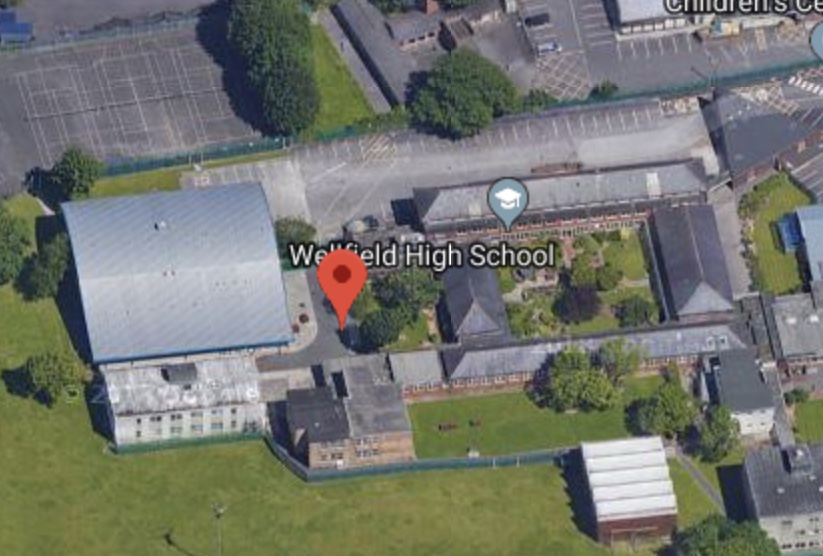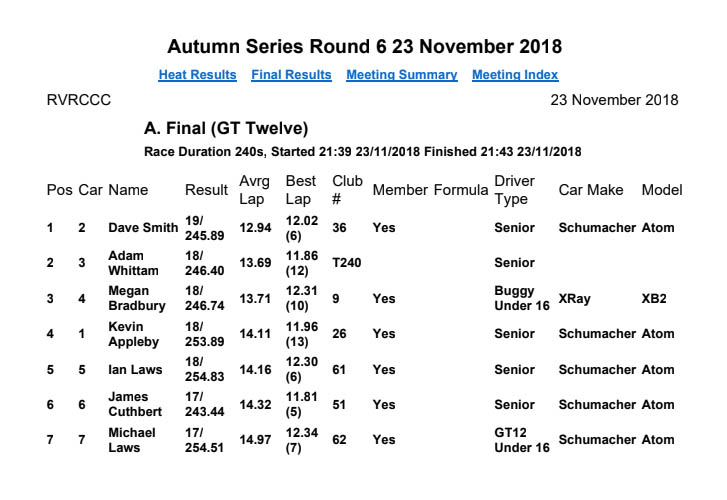The following guide should help you to understand and enjoy RC Car racing at RVRCCC. We welcome drivers of all abilities from complete novices through to experienced racers.
BUGGY AND GT12
RVRCCC race both 1/10th Electric Buggy and 1/12th GT12. Please refer to the construction rules on the RVRCCC website or request a copy to ensure that your car meets the Club’s requirements.
BOOKING IN
If you want to race, please make an advanced reservation with our RVRCCC Race Booking form under the “LETS RACE!” Section of our website. You must pay at race control so we know you have arrived.
Members can book in on-line for the Friday, from 12 noon on Sunday, Non-Members from 12 noon Tuesday. Booking in forms can be found on the website and in the pinned post at the top of the Facebook page. If non-members book in prior to 12 noon Tuesday then they will be removed from the list.
Booking-in will close at 5pm on Thursday. At this point Race Control will assess if there is a need to drop a heat of a class in order to accommodate the reserves of another class. For buggies it will be if there are 27 or less and for GT12 if 10 or less. This will occur for Championship and Fun nights.
Please note we will not accept bookings after 5pm Thursday. Racers, not booked in are welcome to turn up on the night but they cannot be guaranteed a place and will be slotted into heats where space is available regardless of ability
Fees for members must be paid to the PayPal account (given at the end of booking-in) by 12 noon Tuesday and for non-members by 5pm Thursday – if not paid and there are reserves then the place will be re-allocated.
Please note cancellations after 5pm Thursday will not refunded or carried over
If a driver books in and does not let a Committee Member know prior to 5pm on Thursday that they are unable to attend 2 times within a 4 week period, then whether a member or non-member they will not be able to book in until 9am Thursday on the following week.
The first race starts at around 7.00pm. When you book in, you will need to tell us your name, whether you want to race GT12 (Stock or Mod) or Buggy (2WD or 4WD) and the frequency that you want to use (if not using 2.4gHz), your transponder number or if you want club transponder. For Juniors we need to know if they will be under 16 or under 12 as at 1 January. If using crystals, we advise to have at least 2 frequencies with you, to help avoid any frequency clashes.
The entry fees are as follows:
- Senior Members £6
- Junior Members £5
- Senior Non-Members £7
- Junior Non-Members £6
- 2nd Class £3 (Members and Non-Members)
Transponders – The club uses an automated race control system to manage races, count the laps of cars and record race results. The cars carry “Personal Transponders” (PT) that plug into the battery input on the cars receiver. If you don’t have a transponder, the club have a small number of transponders that can be used, for a small fee (£1).
ARRIVING ON RACE NIGHT
If you intend to compete at one of the race meetings, you should arrive at the track at about 6.00-6:30pm to help build the track. Everyone is expected to get involved in the set-up and dismantling of the track. The faster the track is built, the sooner we can start racing.
WHAT TO BRING
In the sports hall, we have a large pit area to one side of the track. This is where you can set up your pit area where you will have access to plug sockets or extension cables. It is a good idea to bring the following with you:
Table and Chair
Anything from a small 3ft to 6ft table depending on the amount of equipment you need to use on the night.
Lipo Bag
These are mandatory if you are charging LiPo batteries in the school hall. LiPo batteries can be extremely volotile and known to combust without prior warning. (It is also a good idea to keep these batteries in a LiPo bag or fireproof box when stored at home)
Battery Charger
You will get approx. 20mins between each race. This should allow you to top-up your batteries ready for the next race, should you need to do so.
Power
As said previously, power is available via wall sockets and extensions. However, if you decide to bring a 12v battery for your charging, please make sure it is sat on a tray to protect the schools wooden floor from any potential acid spillage.
Car Parking
There is generous parking outside sports hall, there is more than enough space to accommodate our club.

Marshalling
After your race has taken, you are expected to put your car back in your pit area and go straight to your marshelling point (corresponding to your allocated car number) in order for the next race to start promptly. If you are unable to marshal for whatever reason (disability, emergency car repairs etc, you are responible for finding a replacement marshal).
If this is potentially your first visit to our club, we would recommend your take a look at the following pages. Buggy Construction Rules, GT12 Construction Rules, Club Rules
PRACTICE
There may be a chance to practice before the qualifying heats depending on how quick the track is set up. If time permits the practice is normally broken up into Buggy Novice, Buggy Experienced and a separate GT12 session.
If your car leaves the track and is on a non-carpeted area, DO NOT attempt to drive back on to the track. The tyres can damage the wood surface and the school may stop the club from racing there, so please wait for someone to put your car back on the track. This applies to all racing at the club.
DRIVERS BRIEFING
Before the racing begins, a driver’s briefing will take place. You must listen to the instructions that are given.
A list of all the heats will be displayed on the side of the trolley. You should check this as it has important pieces of information relating to your racing: which heat you are in, your car number, which will also be your marshalling position for the qualifying rounds and if using crystals the radio frequency that you will need to use.
QUALIFYING ROUNDS
An announcement will be made over the PA system, calling drivers for the next heat. Qualifying heats are normally 4 minutes long.
The cars are released at 2 second intervals, by calling out the number of the car. This is called a “staggered start” and allows separation between the cars on the track.
Qualifying is against the clock not other drivers. Your time will begin when your car passes over the timing loop for the first time. If during the race, a faster car comes up behind you, do not block it, instead you should pull to one side and allow the faster car through. If you are going faster than another car wait for them to pull over (or make a mistake), and pass them cleanly. Accidents will happen, but do not deliberately crash into other cars.
At the end of the heat the computer will signal race over. You should then turn off your car and transmitter and quickly go to your marshal point, which will be identified by a numbered bucket. Your marshal point will be the same as your car number.
Whilst marshalling you should remain alert at all times and be as quick as possible getting to cars that need assistance. However, never put yourself at risk, such that a car can hit you. Remember these cars are travelling at high speeds, and if they do hit you, they can cause injuries.
The heat results are put on the board after the race. When you have finished marshalling, you can check the results. Don’t be afraid to chat to other drivers if you need help or advise, they are all very friendly.
FINALS
There are normally three rounds of qualifying. At the end of each round, a list is put up showing the current positions. After qualifying is finished your starting position in the finals is determined by your best heat, I.e. your best number of laps achieved during a qualifying heat.
The finals will be placed on the board near race control. You will again need to check which final you are in, your car number/starting position and which frequency you need to use.
The finals will be the same length as the heats, but instead of a staggered start, there will be a five second countdown followed by a signal for race start. Whilst you are now racing against the other cars, please be courteous to the other drivers and either let faster cars through, or take your time when passing slower cars. More information can be found in the “Drivers/Marshals etiquette” section.
Here’s an example of the final results sheet:

Finally, RC car racing is about having fun and hopefully this guide gives you an idea as to what goes on during a race meeting. The number 1 priority is to have fun (and maybe win) while also allowing others to have fun.
